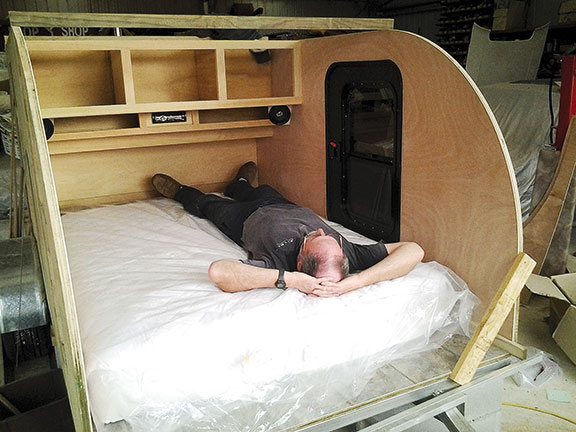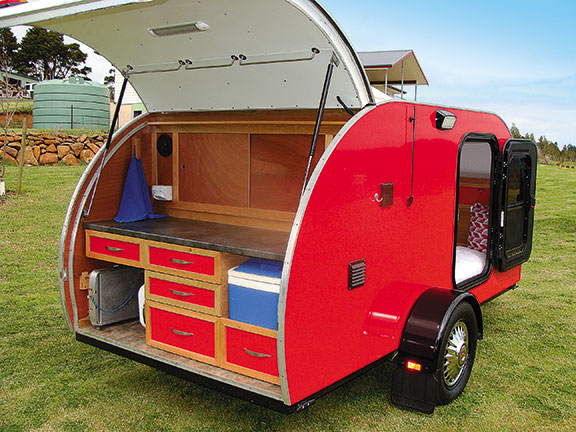We had never really thought about a Teardrop Camper until the last day of June 2012.
That morning we were driving to Auckland to visit the in-laws and had just received a letter from the office of the British High Commissioners informing us of an all-British car rally planned for February, 2013. It would be a touring rally from Auckland to Christchurch, following the same route as a previous rally in 1997.
We had already entered The National Classic Car Rally in Christchurch in October 2012 and had our accommodation booked. My wife Dale suggested that maybe, if we were going to do both trips, we should take the caravan instead of staying in motels.
If we had been taking our 1967 Humber Super Snipe that may have been OK but as the intention was to take the 1962 Ford Capri, there was no way I was going to tow the caravan to Christchurch and back twice with it, over 5600km with a 50 year old 1.5-litre car. On the drive to Auckland we were throwing ideas around when one of us suggested, "All we need is a bed on wheels. What about one of those little bubble-shaped things?"
We arrived in Auckland and Dale got on the 'net, looking to see what she could find either for sale or hire, but found very little to choose from. We arrived home the following night and listed our caravan for sale online. It was sold in a week. That meant we could start looking a bit more seriously.
With no suitable contenders in New Zealand, we looked off shore to Australia, UK and USA. This also drew a blank. Australia took about six weeks to reply (too late by then), and as for the company in the USA, they finally realised we had been doing our homework and suggested that they could send us one in flat-pack form.
We replied recommending they leave out chassis, axle, wheels, 110V wiring, etc., as we were better to do that here, and keep the weight down for shipping. That was the last we heard from them — their website has gone and we assume the company went belly up.
Finally, I said, "Let's build our own!"
We had already lost about two weeks and were booked on the Interislander at 8am on Friday, 12 October, with plans to leave Whangarei by the previous Wednesday afternoon, with a stop somewhere in the middle of the North Island.
I had been looking at various ideas on the 'net and had a rough plan in my head.
Construction started on Thursday, 19 July, 2012, with the cutting of the steel for the chassis. By Sunday night, that was all welded and the floor was in place.
Now we had just 10 weeks to go. Not forgetting the need to go to work, late nights and wet days kept progress humming along. While I was building, Dale was busy locating and ordering components.
Side doors were one of my main concerns. I wanted to make sure they were secure and water tight. We finally settled on doors, ready made for Teardrop Campers from Little Guy in the USA. They have opening windows and bug screens, deadlocks and double weather seals. When we first contacted them they said we wouldn't want them, as the shipping would be too expensive. We did realise that the shipping would probably double the price, but they still ended up about a third the price of some we could have had made locally.
By Wednesday 10 October, we were still fitting out the galley and putting the trims around the edges of the body.
Dale was all excited as I was, by now, letting her use the power tools. Never mind we were supposed to be somewhere around Cambridge by that time. We eventually finished working on the Teardrop at midnight, and fell in to bed about 1.30am.
We left home at 4.30am on Thursday 11 October, and (allowing for a few rest stops) arrived in Wellington (about 850km from home) at 9.45 that night. All in a 50-year-old car that I have owned for 30 years that had not previously had anything on the tow-bar until we pulled out of the gate that morning. Everything went amazingly well, the TD towed like a dream and the car did what was needed, despite the engine fumes coming out of everywhere on all the hills.
We were amazed by the amount of attention the combination attracted along the way, with people wanting to look and take photos every time we stopped. We spent the week camped in Christchurch with a large gazebo for an awning and, despite the rain and southerly wind for the first few days, we were extremely well set up and even hosted a BBQ for eight one evening.
The car rally went well, too. We reunited with many friends we've made during the years the event has been held. With lots of nice cars to travel with, and interesting places to visit, we toured on all sorts of back roads to destinations such as Mt Lyford, Akaroa and Geraldine. We also had a good look around Christchurch to see all the changes since we were there last. To finish the week off with a high, we came home with the over-all winner's trophy.
Soon after we got home it was time to pull the engine out of the Capri for a total rebuild, as well as finish things that hadn't been completed in the Teardrop, before the next big trip in February, 2013.
Next outing was a trip to Taipa in early January for the Auto Spectacular. This time Dale towed the Teardrop behind the Super Snipe while I was running in the engine of the Capri. We had two nights there on the hill above Cable Bay. New Zealand is just so beautiful. Lots of fabulous cars there to see, so I am told, but we didn't get a chance to look at them as we were stuck all day talking to people about the Teardrop.
At the end of January 2013, we went to Cambridge for a cousin's 50th birthday and took our bed with us again.
By February 2013, the camper was finally completed and we — and a few hundred others — left the Auckland Domain heading for Christchurch on The Great British Car Rally. For this trip we were going to be just one night in each destination, so we left the gazebo behind and took an RV shade. This stood out from one side to provide a room for changing, and space for table and chairs.
The route this rally took was through Tauranga, Whakatane, Gisborne, Napier, Masterton, Wellington, Kaikoura and then to Christchurch. No more fumes in the car this time and it performed a lot better.
The nitty gritty
Construction was quite basic, with a galvanised tube for the chassis, on a torsion axle. The floor and sides were constructed from 19mm construction ply with the sides then lined inside with 4mm ply (some sort of Indonesian hardwood) and outside with aluminium/composite signboard, ready painted. Interior cabinets are kauri ply and kauri timber, with off cuts of the 4mm inset in the doors. Inner roof lining is another signboard and outer roof is the alloy, same as the sides, and insulated between the two skins.
The body is 3m x 1.5m, interior bedroom space 1.445m x 2m with a double long inner-sprung mattress. We could have squeezed in a queen but the double gives room down the sides to tuck in the bedding. Overhead lockers at the back give ample room for storing clothes, toilet bags, etc. Under this is a shelf with stereo and room for books and magazines or what have you. To the front, glovebox-like bins are ideal for smalls, socks, etc., with a large storage area below that. We have a roof vent with fan and all lighting, inside and out, is 12V LED. We have 230V outlets in the back wall above the bed and in the galley.
At the back the hatch lifts up, supported by gas struts, and provides a roof for the galley. Above the bench a large cupboard with sliding doors and wire baskets provides ample lightweight shelving. Below the bench are drawers, a gas BBQ, a 12-volt cooler and a single-burner gas cooker. There is a charger for the battery which provides power for the LED lighting, stereo and cooler. The battery is also charged from the car when travelling.
The 'van weighs between 500kg and 600kg, depending on what we have on board at the time. With a body width of 1.5m and a total height of 1.6m, and with the curved front, it is extremely easy to tow. With the galley setup, it is easy to pull into a rest area, lift the hatch, and make a cuppa. Just don't expect to get away without having to give some one the guided tour.
Teardrop Trailer history
The prototype of the enduringly popular Teardrop Trailer was designed and built in America in the 1930s by Louis Rogers of Pasadena, California, for his honeymoon.
His plans were later published in a 1939 issue of Homecraft magazine, and versions also appeared in the September 1947 issue of Mechanix Illustrated.
The secret of the Teardop Trailer's early success lay in its lightweight, easy construction. After two wars and a world-wide depression, the American economy was at the time in recovery with a massive network of highways under construction and abundant WWII surplus materials.
The exterior skins of many early Teardrops were constructed of aluminum salvaged from the wings of bomber aircraft. Wheels frequently came from ex-army jeeps, while the chassis was constructed from U-channel steel or tubing. Fuel was still expensive and the majority of American cars from this era were low on horsepower. The Teardrop was so lightweight it could be towed by a motorcycle and the popularity of this humble trailer continued into the 1950s. At the beginning of the decade, when Popular Mechanics published plans for a 'Woody' version of the Teardrop, they came complete with a trailer-load of construction wood.
However, clamour for the tiny camper, which takes its name from its sleek, aerodynamic shape, declined throughout the '50s as the demand for larger RVs increased while petrol prices dropped to as low as 10-20 cents per gallon.
The first Teardrops were designed to maximise use of a standard four-foot by eight-foot sheet of plywood. Today, most Teardrops are between 1.2m (four feet) and 1.8m (six feet) in width and between 2.4m and 3m in length. The trailers usually sleep two people and have internal storage for clothes and other items. A frequently basic galley is located in a rear hatch.
After a brief period of public disenchantment, the popularity of Teardrops is at an all-time high with home-builders and their clubs now found throughout North and South America, the United Kingdom, Europe, Israel, South Africa, Australia and New Zealand. Commercially-constructed models are also available.
Plans for Teardrop Trailers have been available for download online since the 1990s.
I guess it's no surprise — a sleek, compact and economical vehicle such as this was never going to stay out of fashion for long.
For the latest reviews, subscribe to our Motorhomes, Caravans & Destinations magazine here.

Event preview: NZMCA Motorhome, Caravan & Leisure Show 2025
The NZMCA Motorhome, Caravan & Leisure Show returns to Wolfbrook Arena in Christchurch later this month, with doors opening on













